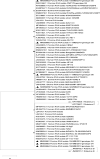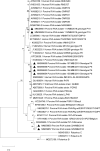Detection and molecular characterization of rotavirus of pigs in Kerala, India
- PMID: 33381628
- PMCID: PMC7749024
- DOI: 10.1007/s13337-020-00621-y
Detection and molecular characterization of rotavirus of pigs in Kerala, India
Abstract
Group A rotaviruses (GAR) are an important cause of diarrhoea in infants and newborn animals especially pigs. In this paper, we report the detection, G and P typing and phylogenetic analysis of GAR of pigs in Kerala. A total of 100 fecal samples from diarrhoeic piglets were collected from organized farms in Wayanad, Ernakulam, Thrissur, and Palakkad districts of Kerala. The samples were tested for the presence of GAR employing reverse transcriptase polymerase chain reaction (RT-PCR) targeting VP6 gene. Positive samples were tested by G and P genotyping primers and representative amplicons were sequenced. Of the 100 samples, 12 were positive for GAR. The G and P types detected were G2, G4, G5, G6, G9, P[6] and P[19]. An untypable P type (P21-5 like) was also detected. In some of the samples more than one G type was detected. The nucleotide sequences of G2, G4 and G5 types were similar to those seen in pigs and that of G6 was similar to bovine sequences. G9, P[6] and P[19] sequences showed similarity to human rotavirus sequences. The findings of this study provide the first information on the G and P genotypes of GAR of pigs in Kerala.
Keywords: Nucleic acid sequencing; Phylogeny; RT-PCR; Rotavirus; VP4 gene; VP6 gene; VP7 gene.
© Indian Virological Society 2020.
Figures


Similar articles
-
Detection and genotyping of human rotavirus VP4 and VP7 genes by reverse transcriptase PCR and reverse hybridization.J Clin Microbiol. 2009 Sep;47(9):2704-12. doi: 10.1128/JCM.00378-09. Epub 2009 Jun 24. J Clin Microbiol. 2009. PMID: 19553575 Free PMC article.
-
Zooanthroponotic transmission of rotavirus in Haryana State of Northern India.Acta Virol. 2017;61(1):77-85. doi: 10.4149/av_2017_01_77. Acta Virol. 2017. PMID: 28161962
-
First study conducted in Northern India that identifies group C rotavirus as the etiological agent of severe diarrhea in children in Delhi.Virol J. 2017 May 30;14(1):100. doi: 10.1186/s12985-017-0767-8. Virol J. 2017. PMID: 28558823 Free PMC article.
-
Distribution of G (VP7) and P (VP4) genotypes of group A bovine rotaviruses from Tunisian calves with diarrhoea.J Appl Microbiol. 2014 Jun;116(6):1387-95. doi: 10.1111/jam.12469. Epub 2014 Mar 3. J Appl Microbiol. 2014. PMID: 24905214
-
Porcine group A rotaviruses with heterogeneous VP7 and VP4 genotype combinations can be found together with enteric bacteria on Belgian swine farms.Vet Microbiol. 2014 Aug 6;172(1-2):23-34. doi: 10.1016/j.vetmic.2014.04.002. Epub 2014 Apr 13. Vet Microbiol. 2014. PMID: 24837191 Review.
References
-
- Afrad MH, Matthijnssens J, Moni S, Kabir F, Ashrafi A, Rahman MZ, Faruque AS, Azim T, Rahman M. Genetic characterization of a rare bovine-like human VP4 mono-reassortant G6P [8] rotavirus strain detected from an infant in Bangladesh. Infect Genet Evol. 2013;19:120–126. doi: 10.1016/j.meegid.2013.06.030. - DOI - PubMed
-
- Estes MK, Kapikian A. Rotaviruses. In: Knipe DM, Howley PM, Griffin DE, Lamb RA, Martin MA, Roizman B, Straus SE, editors. Fields virology. 5. Philadelphia: Lippincott Williams and Wilkins; 2007. pp. 1917–1974.
LinkOut - more resources
Full Text Sources
Research Materials
Miscellaneous

